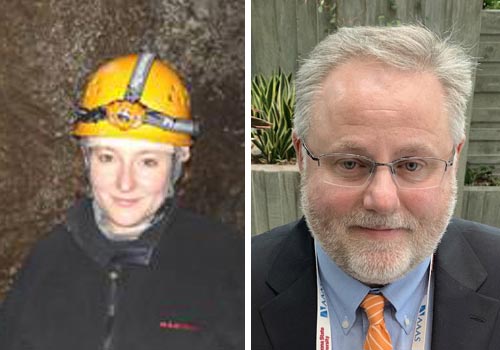Two Professors Named AAAS Fellows
News

Two Professors Named AAAS Fellows
November 26, 2019
Two UT professors have been named Fellows of the American Association for the Advancement of Science (AAAS). Fellows are named in recognition of scientifically or socially distinguished efforts to advance science or its applications.
Annette Summers Engel and Christopher M. Fedo, both professors in the Department of Earth and Planetary Sciences, will receive their AAAS rosette pin in a ceremony in February during the 2020 AAAS Annual Meeting in Seattle.
AAAS is the world’s largest general scientific society and publisher of the journal Science.
Engel, the Donald and Florence Jones Professor of Aqueous Geochemistry, is recognized for distinguished contributions to the fields of biogeochemistry and geology through the use of an environmental systems approach to cave environments and implications of microbiomes to geology.
Engel studies how microbes interact with rocks and minerals over time and how those interactions affect natural systems. She seeks to understand how microorganisms have come to colonize so many different environments on earth. She studies the interactions that happen in caves, aquifers, hot springs, sediments, and coastal marine habitats like marshes and sea grass beds, as well as relationships between microbes and animals including insects, clams, and alligators.
Engel holds a PhD from the University of Texas at Austin focused on the disciplines of geochemistry and geomicrobiology. Her research work has taken her to sites around the world including Yellowstone National Park in Wyoming, El Tatio geyser field in the northern Atacama Desert of Chile, the Tengchong geothermal area of China, Movile Cave in Romania, the Frasassi Caves in Italy, and Karst Springs and Caves in Slovenia, as well as Italy, the Bahamas, Mexico, and China.
She is a fellow of the National Speleological Society, the Geological Society of America, and the Explorers Club.
Fedo, the McSween Chair of Earth and Planetary Sciences, studies the settling and shifting of sediment during the Precambrian era, the earliest eon of the planet’s history. His research is also aimed at understanding the environments and conditions of the early earth’s surface, especially in connection with major transitions in tectonics, climate, and evolution. He is a member of the Mars Science Laboratory research team and uses multiple instruments on the Curiosity rover to study the composition and environments of the sedimentary deposits in the Gale Crater on Mars.
Through NASA’s Jet Propulsion Laboratory Curiosity program, Fedo has contributed to developing an understanding a of how Mars has changed over the past 3.5 billion years by studying the Gale Crater. The crater is the ancient remnant of a massive impact. Sediment carried by water and wind eventually filled in the crater floor, layer by layer. After the sediment hardened, wind carved the layered rock into the towering Mount Sharp. Now exposed on the mountain’s slopes, each layer reveals a different era of Martian history and holds clues about the prevailing environment at the time.
—
CONTACT:
Karen Dunlap (865-974-8674, kdunlap6@utk.edu)
Amanda Womac (865-974-2992, awomac1@utk.edu)